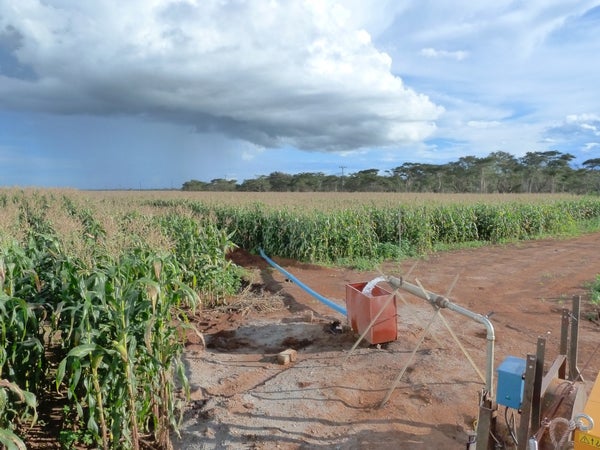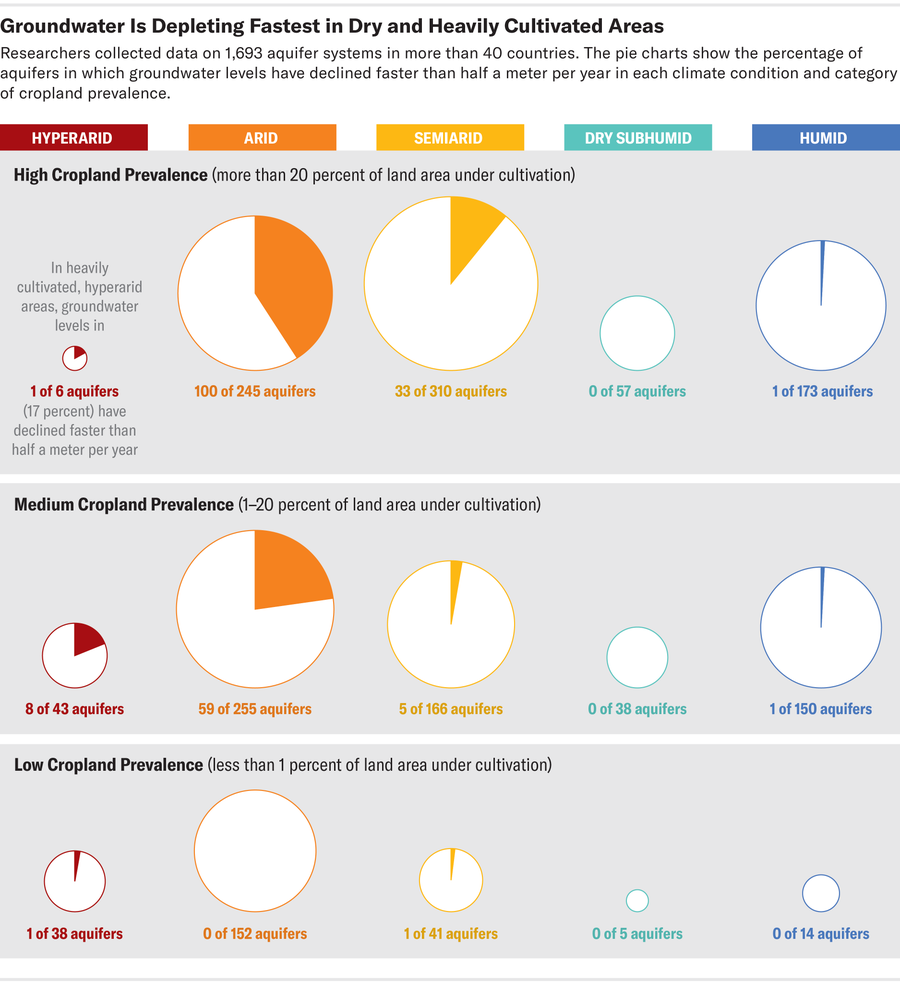Groundwater Is Declining Globally, but There Are Hopeful Exceptions
January 24, 2024
4 min read
The most detailed global look at groundwater yet shows a lot of loss but also stories of success in restoring some aquifers
Groundwater-fed irrigation of maize in Kabwe, Zambia.
In 1997 Union County in southern Arkansas faced a serious crisis: its key water source, the Sparta Aquifer, was declining by as much as two meters per year. This underground reservoir of water trapped within pores and fractures in rock was the county’s only supply, and it was disappearing.
“If we didn’t do something in five years or less, we were going to lose our water source,” says Sherrel Johnson, projects manager for the Union County Water Conservation Board, which formed in response to the crisis.
Just two years later the county’s water board instituted a new groundwater pumping fee, and citizens voted for a temporary tax to pay for $65 million worth of new infrastructure—to draw and treat water from the nearby Ouachita River instead. Today the part of the aquifer that once showed steep declines is now 36 meters higher than it was in 2004.
A study published on Wednesday in Nature suggests other places may need to look to Union County’s example. The new research shows that crucial aquifers around the world are drying up. And in 30 percent of such cases, the current drop-offs are happening faster than ever before. “Groundwater is declining rapidly, especially in dry places where cultivation is widespread,” says study leader Scott Jasechko, an assistant professor of water resources at the University of California, Santa Barbara.
In the Great Plains, the Ogallala Aquifer (a massive underground reservoir stretching from Texas to South Dakota) is becoming depleted in many places as farmers draw on the region’s groundwater to irrigate their crops, especially in times of drought. In 2022 alone, for example, average groundwater levels across western and south-central Kansas dropped by 0.6 meter, according to the Kansas Geological Survey.
Many aquifers are monitored at wellheads, but scientists have long supplemented these data with more approximate satellite measurements to get a rough global picture of depletion. Until now, no one had combined detailed, on-the-ground monitoring with a worldwide scope, the authors say. Jasechko and his collaborators did just that by gathering wellhead monitoring data from 170,000 wells in 1,693 aquifer systems in more than 40 countries.
These data show that 36 percent of aquifers are losing water at more than 0.1 meter per year and that 12 percent are declining at more than 0.5 meter per year. Among aquifers for which there were enough data to compare current trends with the years 1980 to 2000, 30 percent show accelerating losses. The aquifers that are losing water tend to be in regions that are also experiencing declining precipitation over time. “During droughts, in drylands, humans tend to rely on groundwater more,” Jasechko says.
The news from the new study wasn’t all bad, however. In 20 percent of the aquifers that had been monitored long-term, declines are slowing rather than accelerating. In 16 percent, a declining trend has reversed. And in 13 percent, the aquifer has actually grown over time. “We are seeing a very complex picture,” says study co-author Mohammad Shamsudduha, a risk and disaster reduction researcher at University College London.
The findings show that groundwater depletion isn’t inevitable, Jasechko says. In the places where groundwater loss is slowing or where aquifers are refilling, these trends are usually caused by human decisions. In Bangkok, for example, new fees on private well pumping were instituted in the early 2000s; this reversed groundwater losses and slowed the massive city’s land subsidence problems. Outside of Tucson, Ariz., a project that began in 2008 now uses water from the Colorado River to refill the once struggling Avra Valley Aquifer.
Such changes can be controversial, says Johnson, who spearheaded the effort in Union County. “Paying for water was the toughest challenge,” she says, referring to the fact that industries that originally pumped water from the aquifer for free had to start paying a fee. But the infrastructure, built largely with county tax dollars and the water-pumping fee, now supplies the county’s main industries with river water, Johnson says, and that infrastructure has proven a boon for luring new development.
“You have to have trusted leadership,” she says, “and good science and tenacity.”
January 24, 2024
4 min read
The most detailed global look at groundwater yet shows a lot of loss but also stories of success in restoring some aquifers

Groundwater-fed irrigation of maize in Kabwe, Zambia.
In 1997 Union County in southern Arkansas faced a serious crisis: its key water source, the Sparta Aquifer, was declining by as much as two meters per year. This underground reservoir of water trapped within pores and fractures in rock was the county’s only supply, and it was disappearing.
“If we didn’t do something in five years or less, we were going to lose our water source,” says Sherrel Johnson, projects manager for the Union County Water Conservation Board, which formed in response to the crisis.
Just two years later the county’s water board instituted a new groundwater pumping fee, and citizens voted for a temporary tax to pay for $65 million worth of new infrastructure—to draw and treat water from the nearby Ouachita River instead. Today the part of the aquifer that once showed steep declines is now 36 meters higher than it was in 2004.
A study published on Wednesday in Nature suggests other places may need to look to Union County’s example. The new research shows that crucial aquifers around the world are drying up. And in 30 percent of such cases, the current drop-offs are happening faster than ever before. “Groundwater is declining rapidly, especially in dry places where cultivation is widespread,” says study leader Scott Jasechko, an assistant professor of water resources at the University of California, Santa Barbara.
In the Great Plains, the Ogallala Aquifer (a massive underground reservoir stretching from Texas to South Dakota) is becoming depleted in many places as farmers draw on the region’s groundwater to irrigate their crops, especially in times of drought. In 2022 alone, for example, average groundwater levels across western and south-central Kansas dropped by 0.6 meter, according to the Kansas Geological Survey.
Many aquifers are monitored at wellheads, but scientists have long supplemented these data with more approximate satellite measurements to get a rough global picture of depletion. Until now, no one had combined detailed, on-the-ground monitoring with a worldwide scope, the authors say. Jasechko and his collaborators did just that by gathering wellhead monitoring data from 170,000 wells in 1,693 aquifer systems in more than 40 countries.
These data show that 36 percent of aquifers are losing water at more than 0.1 meter per year and that 12 percent are declining at more than 0.5 meter per year. Among aquifers for which there were enough data to compare current trends with the years 1980 to 2000, 30 percent show accelerating losses. The aquifers that are losing water tend to be in regions that are also experiencing declining precipitation over time. “During droughts, in drylands, humans tend to rely on groundwater more,” Jasechko says.
The news from the new study wasn’t all bad, however. In 20 percent of the aquifers that had been monitored long-term, declines are slowing rather than accelerating. In 16 percent, a declining trend has reversed. And in 13 percent, the aquifer has actually grown over time. “We are seeing a very complex picture,” says study co-author Mohammad Shamsudduha, a risk and disaster reduction researcher at University College London.
The findings show that groundwater depletion isn’t inevitable, Jasechko says. In the places where groundwater loss is slowing or where aquifers are refilling, these trends are usually caused by human decisions. In Bangkok, for example, new fees on private well pumping were instituted in the early 2000s; this reversed groundwater losses and slowed the massive city’s land subsidence problems. Outside of Tucson, Ariz., a project that began in 2008 now uses water from the Colorado River to refill the once struggling Avra Valley Aquifer.
Such changes can be controversial, says Johnson, who spearheaded the effort in Union County. “Paying for water was the toughest challenge,” she says, referring to the fact that industries that originally pumped water from the aquifer for free had to start paying a fee. But the infrastructure, built largely with county tax dollars and the water-pumping fee, now supplies the county’s main industries with river water, Johnson says, and that infrastructure has proven a boon for luring new development.
“You have to have trusted leadership,” she says, “and good science and tenacity.”

